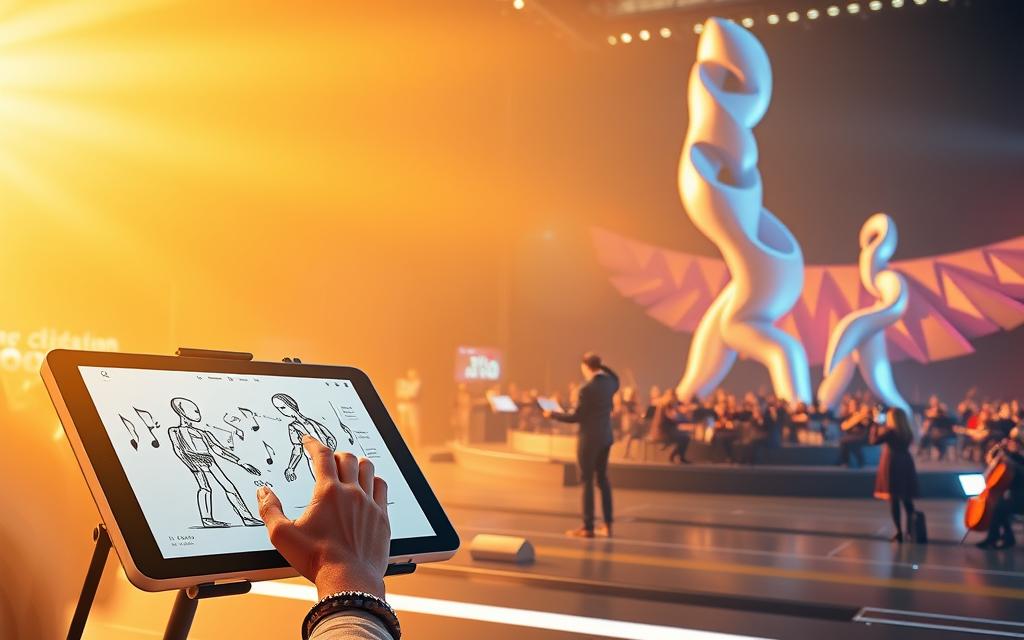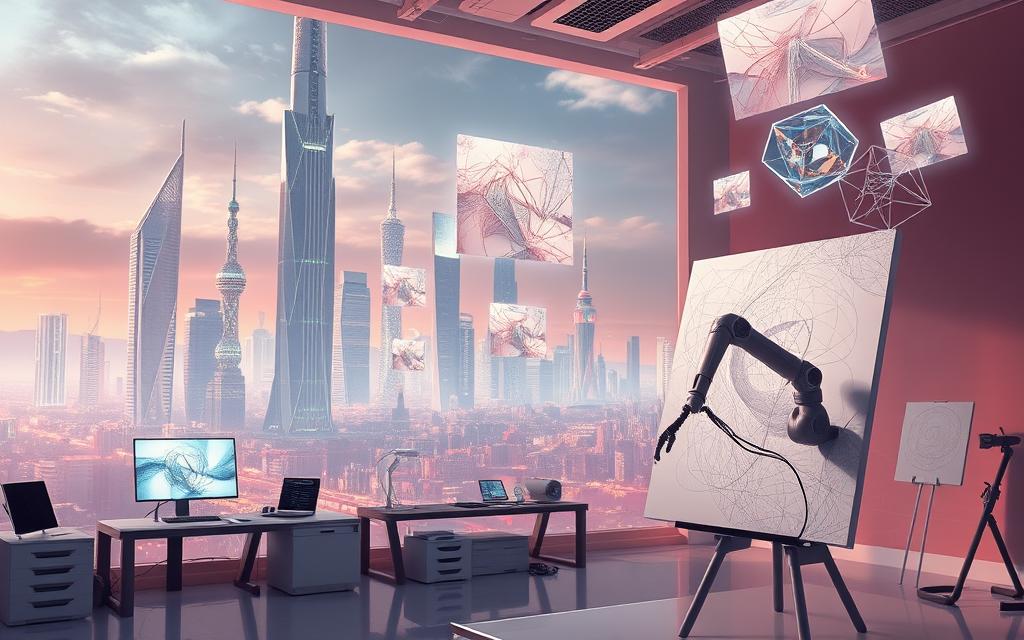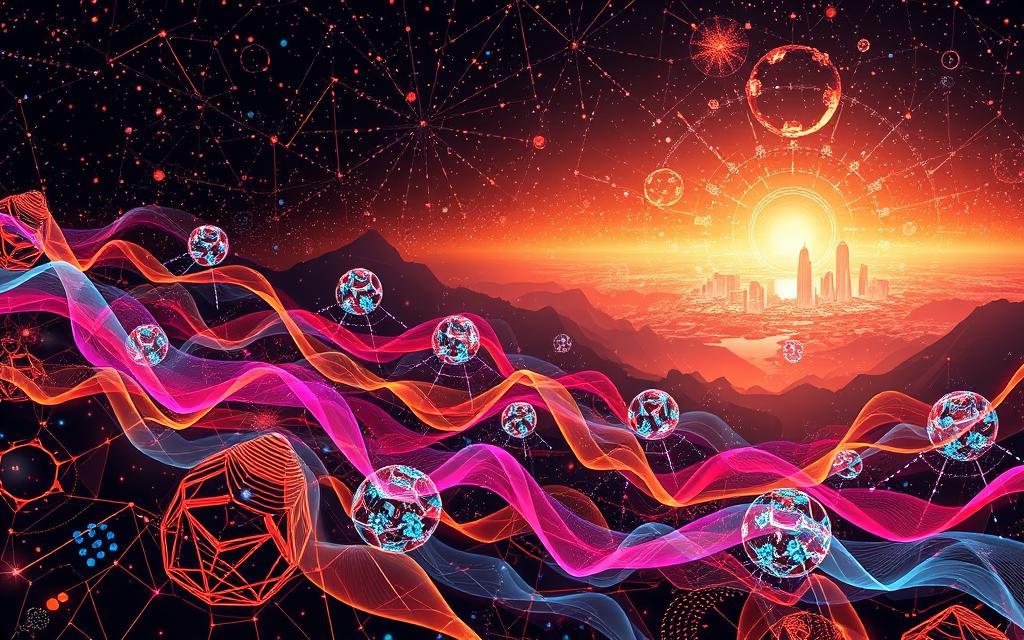The world of art and music is witnessing a revolution with the integration of machine learning art and artificial intelligence in music. Machines are now capable of creating masterpieces that rival those produced by human artists.
The emergence of creative AI applications has opened new avenues for artists and musicians. An ai painter can generate computer-generated art that is not only aesthetically pleasing but also thought-provoking.
This fusion of technology and creativity is redefining the boundaries of art and music, enabling new forms of expression and innovation.
The Evolution of AI in Creative Fields
AI’s journey in creative industries has been a transformative one, evolving from simple rule-based systems to complex neural networks. This evolution has not only changed the way we create art and music but has also opened up new avenues for artistic expression.
From Rule-Based Systems to Neural Networks
The early days of AI in creative fields were marked by rule-based systems that followed strict guidelines to generate art and music. However, with the advent of machine learning and neural networks, AI’s creative capabilities have expanded significantly. Neural networks, in particular, have enabled AI to learn from vast datasets, generating more sophisticated and nuanced creative outputs.

Key Milestones in AI Creative Development
Several key milestones have marked AI’s journey in creative development. The development of algorithms that can analyze and generate art based on styles and techniques has been crucial. Additionally, AI’s ability to compose music that resonates with human emotions has been a significant breakthrough in digital creativity.
How Creative AI Works Today
Today, creative AI works by leveraging complex algorithms and neural networks that can process and generate vast amounts of data. This enables AI to create art and music that is not only aesthetically pleasing but also innovative. The use of artistic algorithms allows AI to push the boundaries of traditional creative practices, leading to new forms of machine-generated art.
Can a Machine Paint a Masterpiece or Compose a Symphony?
The emergence of AI-generated art and music has raised fundamental questions about the nature of creativity itself. As machines become increasingly capable of producing works that rival those created by humans, we are forced to reevaluate our understanding of art and music.
Defining Creativity in Human vs. Machine Terms
Creativity, often considered a uniquely human trait, is now being explored in the context of machines. While humans draw upon a complex mix of experiences, emotions, and knowledge to create, machines rely on machine learning algorithms and data. The question remains whether the creative output of machines can be considered truly original or if it’s merely a sophisticated manipulation of existing patterns.
The distinction between human and machine creativity lies not just in the process but also in our perception of the final product. As AI-generated masterpieces become more prevalent, our understanding of creativity is evolving to encompass both human and artificial forms.
The Technology Behind AI Art Generation

The generation of art by AI is primarily facilitated through two key technologies: GANs (Generative Adversarial Networks) and diffusion models. These technologies enable machines to learn from vast datasets of images and generate new works based on that learning.
GANs and Diffusion Models
GANs consist of two neural networks that work in opposition to each other, one generating images and the other evaluating their authenticity. This process results in the generation of highly realistic images. Diffusion models, on the other hand, work by iteratively refining the input noise signal until it resembles the data it was trained on.
Style Transfer and Image Manipulation
Another aspect of AI art generation is style transfer, which allows for the transformation of images into the style of another image. This technology, combined with image manipulation capabilities, opens up new avenues for creative expression, enabling artists to explore new styles and effects with ease.
How AI Composes Music
AI’s ability to compose music involves a different set of processes than art generation, focusing on pattern recognition within musical structures and the generation of sound through neural networks.
Pattern Recognition in Musical Composition
AI systems analyze vast datasets of musical compositions to understand patterns and structures. This understanding allows AI to generate new compositions that adhere to or innovate upon these patterns.
Neural Networks for Sound Generation
Neural networks are used not only to compose music but also to generate the actual sounds. This involves complex algorithms that can produce a wide range of sounds, from simple tones to complex orchestral pieces.
As creative AI continues to evolve, the potential for machines to not only mimic human creativity but also to innovate within the arts becomes more pronounced. The collaboration between humans and machines in creative endeavors is likely to lead to new forms of art and music that neither could have achieved alone.
Notable AI Art and Music Projects
The creative landscape is being reshaped by AI, with numerous groundbreaking projects pushing the boundaries of artistic expression.
Groundbreaking AI Painters and Their Works
AI painters are creating stunning visual art that challenges our perceptions of creativity and technology. Some notable projects include:
DALL-E, Midjourney, and Stable Diffusion
These AI models are capable of generating high-quality images from text prompts, showcasing the potential of automated art generation. DALL-E, for instance, can create surreal and imaginative art that rivals human creativity.
The “Portrait of Edmond de Belamy” and Art Market Impact
The “Portrait of Edmond de Belamy,” created by the French art collective Obvious using a Generative Adversarial Network (GAN), sold for $432,500 at Christie’s auction house in 2018. This sale highlighted the growing interest in AI-generated art and its potential impact on the art market.
AI-Generated Visual Art in Exhibitions
AI-generated visual art is increasingly being featured in exhibitions worldwide. These exhibitions showcase the capabilities of AI painters and challenge our understanding of creativity and artistic expression.
AI Composers Changing the Music Landscape
AI composers are revolutionizing the music industry by creating complex and beautiful compositions. Some notable projects include:
AIVA and OpenAI’s MuseNet
AIVA and OpenAI’s MuseNet are AI composers that can generate complex musical compositions in various styles. These systems demonstrate the potential of AI in music creation and have significant implications for the music industry.
Google’s Magenta Project
Google’s Magenta project is an open-source research initiative that explores the use of AI in music and art creation. The project has led to the development of various AI-powered music tools and has contributed to the growing interest in AI-generated music.
AI-Generated Film Scores and Commercial Music
AI-generated film scores and commercial music are becoming increasingly popular. These AI composers can create high-quality music that is tailored to specific needs, revolutionizing the music production process.
The Human-AI Creative Partnership
The collaboration between humans and AI is revolutionizing the creative landscape. This partnership is not only enhancing existing artistic processes but also opening up new possibilities for innovation. By leveraging AI’s capabilities, artists and musicians can now explore uncharted territories in their work.
Artists Collaborating with AI
Many artists are now collaborating with AI to create novel and intriguing works. For instance, AI algorithms can generate complex patterns or suggest color palettes that human artists might not have considered. This collaboration can lead to the development of new styles and techniques that blend human creativity with algorithmic creativity.
One notable example is the use of AI in generating art that adapts to its environment. Using machine learning algorithms, artists can create installations that change and evolve based on viewer interactions or environmental conditions.
How AI Tools Are Enhancing Human Creativity
AI tools are increasingly being used to enhance human creativity across various artistic domains. In music, AI can assist composers by suggesting chord progressions or even generating entire musical pieces. In visual arts, AI-powered software can help artists refine their work or explore different styles.
These tools are not replacing human artists but rather augmenting their capabilities. By automating certain tasks or providing new sources of inspiration, AI is enabling artists to focus on the creative aspects of their work. This human-AI creative partnership is leading to the development of new and innovative artistic expressions.
Ethical Questions and Authorship Concerns
As AI becomes more integral to the creative process, it raises important ethical questions and authorship concerns. Who owns the rights to a piece of art generated with significant AI input? How do we attribute the creative work when both humans and machines have contributed?
Addressing these concerns requires a nuanced understanding of the role AI plays in the creative process. While AI can generate art and music, the context, intent, and direction provided by human artists are crucial elements that shape the final product. Thus, the collaboration between humans and AI should be recognized as a partnership that brings about new forms of artistic expression.
The Future of AI in Artistic Expression
The future of AI in creativity is poised to revolutionize the arts, with digital artists at the forefront of this innovation. As AI-generated music and art generation continue to evolve, we can expect to see new forms of musical composition by AI emerge.
Technological creativity will play a significant role in shaping the future of artistic expression. With AI tools becoming increasingly sophisticated, artists will be able to collaborate with machines to produce novel and groundbreaking works.
The future of AI in creativity will be characterized by increased innovation in the arts, as machines and humans work together to push the boundaries of what is possible. As AI continues to advance, we can expect to see new and exciting developments in the world of art and music.







